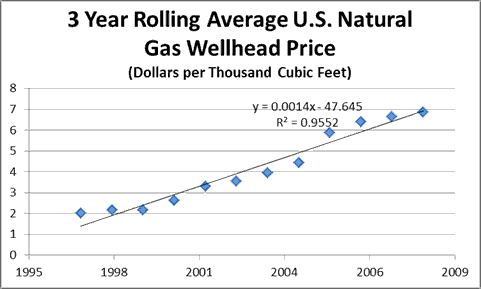Shale Gas Revolution adds $193 Billion to the US Economy
The naysayers and those who want shale gas to go away have not seriously looked at the benefits of lower natural gas prices to the US economy. In this blog, I decided to evaluate the savings the shale gas revolution has given to the US economy. As I have been espousing, energy is just a means to an end. Reducing energy cost, immediately increases value to society. The inverse is also true.
In order to calculate the value of the shale gas revolution, I looked at the natural gas price trend on a three year rolling average from the EIA. I started in 1997 and stopped the graph in 2008 right before the shale revolution presented itself. Interesting to see the three year rolling average price is quite linear with an R^2=0.9552.
Obviously extracting the equation for future years is a plausible method to calculate the price of natural gas without shale gas. However, there are concerns with that method in that eventually prices do hit a plateau as alternative uses and demand response do occur. A cautious and conservative calculation is to assume the price of $7/mmbtu.
With this price, we can cross multiply the consumption and compare the cost to the US economy with or without shale gas. I know one of the first comments would be higher gas prices would have lowered consumption. I will agree with that in principle. However, did you know from 2002 to 2008 gas demand rose in the midst of the largest sustained gas price rise of over 270%? This growth came from the fact the incremental demand of power had to be met. Since the US did not build any significant baseload generation outside gas units over the past 10 years it was left to gas units to fill the gap. The price of electricity is small when compared to the value it can bring therefore a 270% rise in gas price was not going to stop gas demand. In reviewing my math in the table below, I took a conservative view and held demand at 2009 levels in the case of without shale gas.
| With Shale | Without Shale | ||||||
| Wellhead Price | US Demand | Cost of Gas | Wellhead Price | US Demand | Cost of Gas | US Savings | |
| $/MCF | MMCF | $Billion | $/MCF | MMCF | $Billion | $ Billion | |
| 2009 | 3.67 | 22910078 | $ 84.08 | 7 | 22910078 | $ 160.371 | $76.291 |
| 2010 | 4.48 | 23775388 | $ 106.514 | 7 | 22910078 | $ 160.371 | $53.857 |
| 2011 | 4 | 24466323 | $ 97.865 | 7 | 22910078 | $ 160.371 | $62.505 |
| Total | $192.653 |
With the shale gas revolution, the US saw a stimulus to the tune of $193 billion over the last three years. The $193 billion savings to the US economy is conservative in the fact without shale gas more money would have been expatriated via LNG if it were not for shale gas. To put this number in perspective I reviewed the Recovery Act spending. In the grand scheme $193 billion compared to the total Recover Act of $840 represents 23%. On several individual parts of the Recovery Act, shale gas savings dwarfed many categories (e.g. Unemployment benefits $61 Billion, Infrastructure $24.5 Billion, Energy Incentives $10.8 Billion, Housing $5.5 Billion).
The industry needs to learn how to extract and educate the public on the value it has produced for society. Innovation and hard work produces more return and more transparent stimulus to society than any government program could ever create.
I do agree and support the regulation of the industry to limit the amount of bad actors that are willing to cut corners and sacrifice the environment for small increments. Our recent significant problems (Accounting Scandals to Housing/Banking to Oil Spills) can be blamed on the actors directly involved, but there is much blame to be placed on the appointed regulators for each of those industries. Regulatory capture has been and continues to be a constant theme in these economic woes. More rules do not solve the problem; we need better regulators to enforce existing laws and apply common sense.
The administration should thank and embrace those who created and produced this shale gas revolution, as the economy could be $193 billion worse and rising each year.
I have been prescient in forecasting economic calamity and the impact on the major commodity markets (Forecasted both the 1998 Asian Financial crisis and the recent financial crisis and the drop in the major commodity markets in each case).
We positively and evocatively challenge the current thinking involving any aspect of energy use. We look for projects that offer meaningful, transformative, with impactful outcome to the marketplace or society (see projects).
Please consider All Energy Consulting for your consulting needs.
Your Energy Consultant,
Shale Gas Production so now what?
The enormous potential for natural gas production is the essence of the shale gas revolution. Many people are still spending much of their time quantifying it. For those in the commodity trading, planning, or business development space, I think it’s time to move on and examine the opportunities. Shale gas production will not be small. Perhaps it could be medium with potential regulations limiting the development. It may be extra-large if knowledge is increased and the players involved act appropriately. The next important question is where will it all go? As with any product that is introduced, you need to do some market assessment. I can with some certainty pronounce that the bulk of the new gas supply will go to the power market.
Following that premise, the next question will be how it will go to the power sector? The answer to this will vary. As a producer you need to know your customer and how exactly best to market to this new sector. Given my vast oil & gas experience along with my power utility experience I can be that bridge for you to understand what is involved in this transition. Letting nature/market takes its course for you will produce a very rocky outcome. Approaching the transition in a more strategic approach will allow you to unlock more value and avoid significant on-hands learning moments.
Inversely, as a power/utility company, moving to gas will require much consideration as the dynamic of the gas industry is much different than the coal industry. The lingo and the business strategies are almost polar opposites in some cases. The power and gas industry are currently not aligned in the advocacy position of energy policy (or lack of). This will need to change if this transition will be smooth and productive.
At AEC we can act as the bridge for you. We can pull the two sides together to produce a win-win situation. Please call us to learn, reaffirm, and give you a unique perspective on the situation. 614-356-0484 email [email protected]
Natural Gas Price Keeps Falling and Falling – Is there an End?
Gas prices being this low is not amazing. What I do think is amazing is the forward strip. Clearly in the “shoulder” month – high supply and low demand – prices can capitulate. However when demand does pick up as we head into winter it would be very unlikely to have prices stay below $3.50. I documented this phenoman in my presentation that I did at the Platts Coal Properties & Investment Conference. In a nutshell you are seeing for every 10cent drop in price almost 1 bcf/d of more gas consumption in the power sector.
Breaking it down – just from weather in November to December over the past 10 years demand has risen on average 18 bcf/d. Over the last two years over 24 bcf/d. Now given the price impact on the power sector you can expect at least an additional 6 bcf/d above and beyond the weather impact. A total of 30 bcf/d of incremental increase demand in one month has never been seen. Last year we saw a rise of 25 bcf/d and the price responded accordingly.
Last year prices of the henry hub bottomed out at $3.20 then within a month time prices climbed over $4 – peaking at $4.55 in January. Unless weather is abnormally warm I dont expect anything different this year. Coal prices that utilities are paying for (FOB + Delivery) are higher across the board. In the end its the spread that matters not the absolute price of natural gas. The forward curve is seriously discounting the demand surge expected when the winter weather comes.
David K. Bellman




